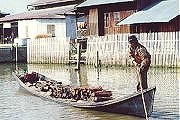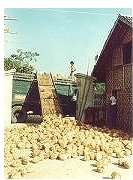

Myanmar 
 |
Wood Energy Situation Policies and Programmes Wood Energy Data Further Reading RWEDP Focal Points |
Wood Energy Situation
Myanmar is endowed with abundant and varied indigenous sources of energy, including hydropower, natural gas, crude oil, biomass, and coal. Since Myanmar's centrally planned economy has not encouraged private sector and external participation, conventional energy consumption is still low. In 1993-4, 78% of total energy consumption came from woodfuels. Biomass is the major source of energy in both the domestic and industrial sectors.
The Government of Myanmar had declared 1995 the year of fuel substitution. Indeed, in some areas shortages of fuelwood are very severe and basic fuel needs are not met, particularly in the dry zone. Deforestation has in the past decade prevailed in the central and southern provinces. The main cause of deforestation in Myanmar may, indeed, be cutting and felling for woodfuel. This was encouraged by the Government in order to save on imported fuels. It is now recognised that agricultural residues and other alternative fuel sources are still largely untapped, while, overall, the country lacks adequate processing and conversion technologies. Large forests still exist in the north, but they are largely outside the reach of the people for fuel. High-level government representatives say severe punishment awaits villagers who illegally cut trees.
Policies and Programmes
Woodfuel substitution efforts attempt to make use of agri-residues supported by briquetting technologies. The Myanmar Scientific and Technological Research Department (MSTRD) which is part of the Ministry of Industry, is actively engaged in this activity. MSTRD co-operated with private sector organisations by offering technical assistance to enterprises and by ordering parts for MSTRD products from private manufacturers. However, modern technologies are not yet available as there is a general lack of international contact. At present, few people have been trained properly or received specialist education.
RWEDP made an effort to introduce improved stoves in 1992. This was taken up by the Forest Department and good results were obtained due to the acceptance of the new stoves. The work is ongoing and a target has been set to disseminate 20,000 improved stoves under current programmes. The Forest Research Institute has involved a private enterprise in the production of the stoves. Dissemination has also been promoted by the FAO Project for Community Multipurpose Fuelwood Woodlots, in Mandalay. It is reported that the present demand for the new stoves is outstripping  supply even though the stoves were found to last for six months only, down from the expected eight months. It will be necessary to monitor and upgrade the quality and expand production capacity. Other (national) FAO projects have also started to address fuelwood shortages and related socio-economic and environmental problems. By now, several government departments and some private sector initiatives have taken up the energy challenge, and UNDP is making an effort to advise the government on new energy policies.
supply even though the stoves were found to last for six months only, down from the expected eight months. It will be necessary to monitor and upgrade the quality and expand production capacity. Other (national) FAO projects have also started to address fuelwood shortages and related socio-economic and environmental problems. By now, several government departments and some private sector initiatives have taken up the energy challenge, and UNDP is making an effort to advise the government on new energy policies.
The Ministry of Energy is mainly interested in modern fuels and is encouraged in this by UNDP. However, the Energy Planning Department considers the best option to be a proper fuel mix differentiated according to whether users are from urban or rural households or from higher or lower income groups.
Wood Energy Data
| General | |||||
| Population (1996) | 45.9 mln. | ||||
| Share of Rural Population | 73.5% | ||||
| GDP per capita (1995) in constant 1987 US$ | 288 | ||||
| Energy Consumption (1995/96) | |||||
| Total Final Energy Consumption in PJ | 384.1 | ||||
| Consumption of Wood Energy in PJ | 323.1 | (84.1%) | |||
| Consumption of Biomass Energy in PJ | 335.8 | (87.4%) | |||
| Wood Energy Resources | |||||
| Forest Area (1995) in 1000 ha | 27,151 | (41.3%) | |||
| Natural Forest Area (1995) in 1000 ha | 26,875 | (40.9%) | |||
| Agricultural Area (1994) in 1000 ha | 10,421 | (15.8%) | |||
| Share of Woodfuels from Forest Areas | NA | ||||
| Potential Wood Energy Supply (1994) | |||||
| Sust. Supply from Natural Forest in kton | 44,957 | ||||
| Sust. Supply from Forest Plantations in kton | 970 | ||||
| Sust. Supply from Agriculture Areas in kton | 6,844 | ||||
| Sust. Supply from Other Wooded Land in kton | 11,782 | ||||
| Supply from Wood Waste from Deforestation in kton | 65,341 | ||||
| Total Potential Supply in kton | 129,935 | ||||
| Primary Wood Energy Requirements in kton | 23,058 | ||||
Notes:
Population and land use data from FAO (FAOSTAT), GDP per capita from World Bank. Energy consumption data from various sources.
Potential wood energy supply estimated by RWEDP, based on available data for land use, wood productivity and estimates on availability of wood for energy use. For forest land, other wooded land and agriculture areas, the potential supply is based on average annual yield estimates, assuming a sustainable use of resources (Sust.: sustainable). Wood waste from deforestation refers to wood potentially available from natural forest land cleared due to commercial logging, expansion of agriculture land or other reasons. The estimates are based on aggregated national data, which can hide local variations, ranging from scarcity to abundance. For detailed calculations and estimates for 2010, see FD50, chapter 8
Further reading:
| Regional Study on Wood Energy Today and Tomorrow in Asia, Field Document 50, 1997 | |
| Chapter 10 in Review of Wood Energy Data in RWEDP Member Countries, Field Document 47, 1997 | |
| Report of National Training Workshop on Woodfuel Trade in Myanmar, Yezin, Myanmar, RWEDP Report No. 33, 1997 | |
| Report Woodfuel Flows: An overview of four studies, RWEDP Report No. 30, 1997 | |
| Woodfuel Flows in the Dry Zone of Myanmar - A Case Study, Field Document No. 39, 1993 |
Focal points are the main contacts for RWEDP in a member country. Generally, in each country, there is one focal point in the energy sector, and one in the forestry sector.
| Director General Forest Department Bayintnuang Road West Gyogone, Insein T. S., UOM 62 Phayre Street, Yangon TEL: 95-1-71664 FAX: 95-1-22964 | Director General Energy Planning Department Ministry of Energy 74-30 Minye Kyawzwa Road Yangon TEL: 95-1-20005 FAX: 95-1-22964 |
Comments, questions? webmaster@rwedp.org
© FAO-RWEDP, 1999